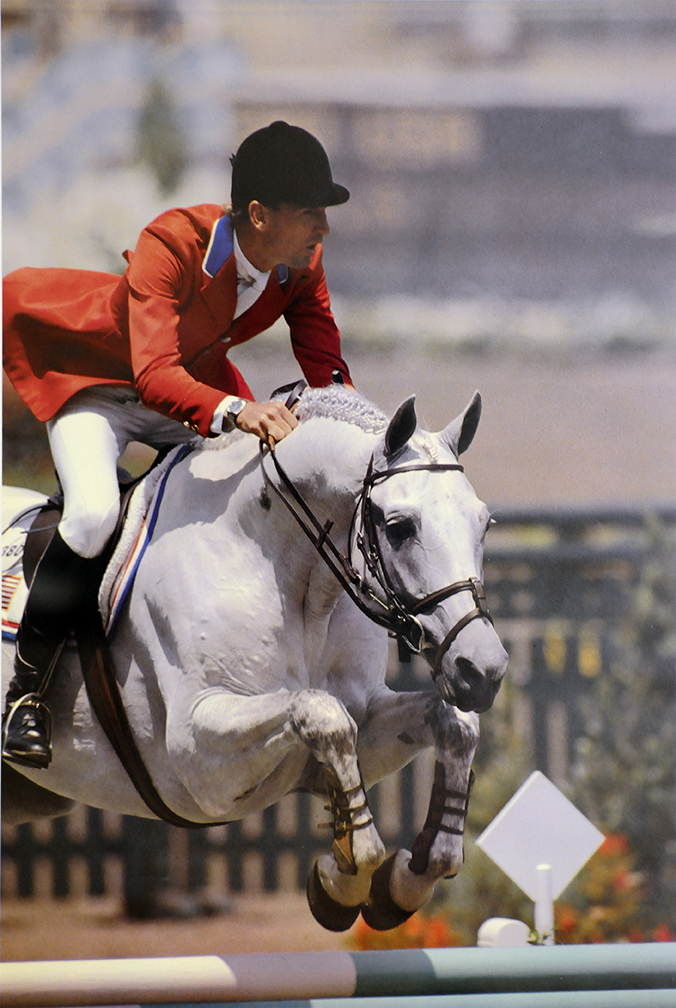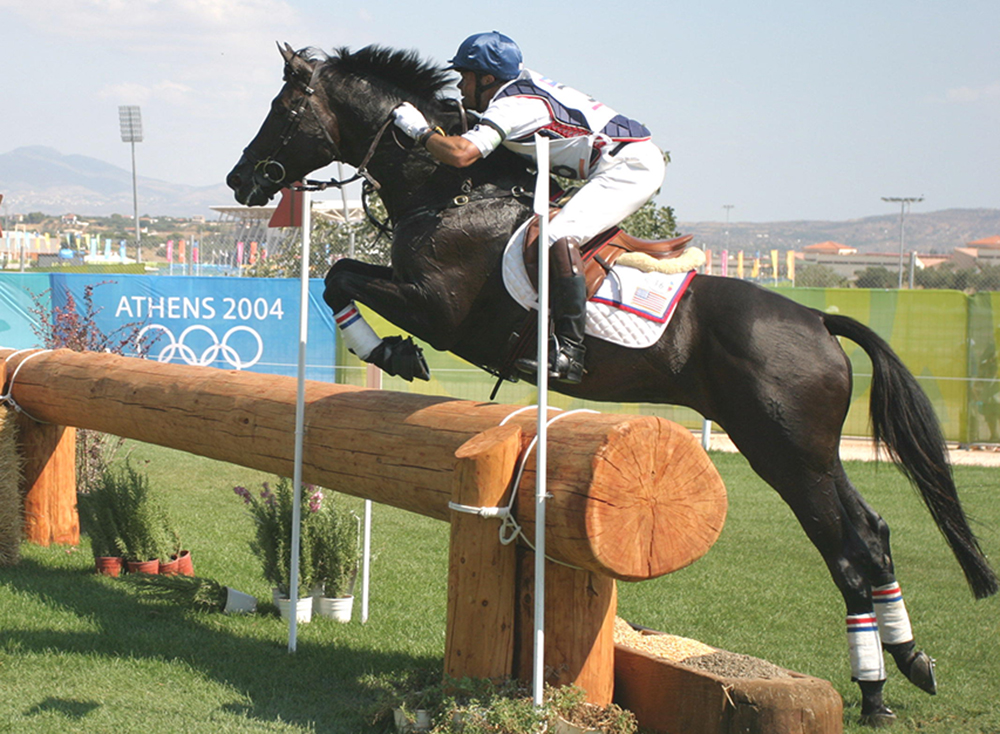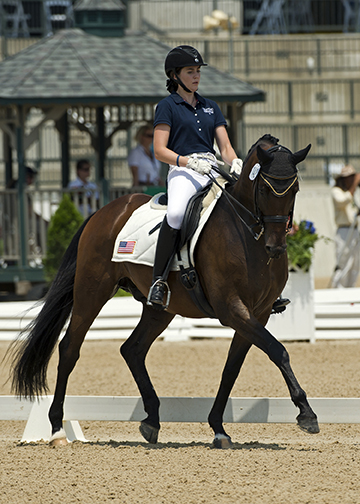
courtesy of the American Trakehner Association
Trakehner horses are the oldest of warmblood breeds, with a studbook dating to 1732. They have been systematically "engineered" for performance--first as cavalry mounts in East Prussia, later as the refined sport horses that have gained the Trakehner breed its international acclaim.
King Friedrich Wilhelm I of Prussia, the father of “Frederick the Great,” saw the changing face of war required a lighter horse, more comfortable to ride over long distances, with more endurance and speed than the heavy horses previously needed to carry armor and haul military equipment. So he chose the best horses from seven of his royal breeding farms, and in the early 1700s moved them all to the new Royal stud at Trakehnen, East Prussia. Through careful crossing of those horses with a hardy native horse called “Schweike” and adding only English Thoroughbred or "oriental" blood, a horse of nobility, elegant movement and great endurance was developed.
Almost 300 years later, strict selection and performance continue to be the hallmarks for today’s Trakehner. The smallest in number of other warmblood breeds, Trakehners are used as refiners for other breeds, resulting in a much higher Trakehner presence than is evident in registrations. For example, Blue Hors Matine, winner of the individual Silver and Bronze medals in dressage at the 2006 World Equestrian Games in Aachen, was sired by Trakehner stallion Silvermoon but registered as Danish Warmblood. Similarly, KWPN-registered Totilas, holder of three Gold medals in dressage from the 2010 World Equestrian Games in Kentucky, was sired by Trakehner stallion Gribaldi out of a Dutch Warmblood mare.

Intensive, selective breeding has always been practiced, with only the best horses allowed to reproduce. The resulting sport horse is thus highly suitable for all Olympic disciplines. Since 1984, Olympic medals won by horses registered with the American Trakehner Association (ATA) have gone to three Trakehner stallions on U.S. teams: Abdullah was the team Gold and individual Silver medal-winning jumper in 1984 in Los Angeles; Peron was the Bronze medalist in dressage in 1996 in Atlanta; and Windfall was a team Bronze medal-winning eventer in 2004 in Athens and won Pan Am Gold in 2003. The ATA eventing mare Larissa competed for Canada in two consecutive Olympic Games and won a team Silver medal at the Pan American games in Santo Domingo in 2003. More recently, ATA member Jessica Phoenix rode her mare A Little Romance in the 2016 Rio Olympics as a member of the Canadian eventing team.
Although the Olympic horses mentioned above were all ATA registered, many other international competitors have selected Trakehners for their ride—including the multiple medalists Anky van Grunsven with Partout, the late Reiner Klimke and Biotop, Elmar Gundel on Almox Prints, Hap Hansen with Horalas, Edward Gal riding both Gribaldi and Totilas, Theo Hanzon on Hofrat, Michael Jung riding both Der Dürer and Grafenstolz, and William Fox-Pitt on Seacookie.
Trakehners won the Gold and Silver medals in dressage in the 1924 Olympic Games. In the 1928 Olympics, a Trakehner won the Bronze medal in the three-day event. And, in the 1936 Olympics, known as “the year of the Trakehner,” Kronos won the Gold medal in dressage, while Absinth won the Silver. The Gold medal in the three-day event that year went to Nurmi. But the following years were not kind to the breed, and it came close to extinction.
Deep in the winter of early 1945, Prussian Trakehners and their owners attempted to escape westward before an advancing WWII Soviet army. That journey has become infamous as "The Trek." Both people and horses endured extreme hardships. Hitching their precious breeding stock to carts loaded with their possessions, the populace—almost entirely women, children, and elderly—fled over snow-drifted roads and frozen rivers while being attacked from both air and ground. Almost 600,000 East Prussian citizens died, many of them and their horses lost when they fell through the ice. From a pre-war Trakehner breeding population of 25,000 broodmares and 1,200 approved stallions, only 1,500 could be found in Germany.
From the main stud of Trakehnen, only 27 broodmares were saved. A few were confiscated and taken behind the Iron Curtain to create very small breeding populations in Russia, Poland and Lithuania. The most important stallions were lost during The Trek, but others were captured and taken to Kirov, where they established a stud responsible for producing one of today's most powerful sport horses, the Russian Trakehner. Almost 60 young colts were evacuated to the German state stud at Celle earlier in the war. Some were gelded and others were confiscated by the English, French and American armies at war's end.
After WWII, many of the other European warmblood breeds used remaining Trakehners to refine their horses. Examples are Herbststurm, who influenced the Oldenburg, Marco Polo with Dutch Warmblood, Ibikus for the Danish Warmblood, Polarstern for the Swedish Warmblood and Chrysos with Westphalian. Perhaps one of the most influential Trakehner sires for another breed is that of Abglanz for the Hanoverian. He is credited with bringing about improvement in the head and neck of the Hanoverians of that day, and sired 19 approved sons. Abglanz was one of those few colts evacuated to Celle.
At the end of the war, Dr. Fritz Schilke, executive director of the East Prussian Stud Book Society, tried to locate all the East Prussian horses that had made it to the West. He established the West German “Trakehner Verband” and a Trakehner Stud Book that continues to document the breed today. In those early days, many horses could be identified only by the moose antler brand on their hips. Their registration read, “papers lost due to the events of war–identified as Trakehner by its brand.”
The first Trakehners were imported to North America in the 1950s by Gerda Friedrichs of Keswick, Ontario, Canada: three stallions and a dozen mares. Soon after, more began arriving in the United States. In 1974, the ATA was founded for the “promotion and preservation in the Western Hemisphere of the warmblood horse of Trakehner origin.” In 1978, the ATA signed an agreement of cooperation with the German Trakehner Verband, promising to breed Trakehners in North America according to the same selective breeding and performance testing principles practiced in Germany.
The ATA is now one of 10 affiliated organizations of the Trakehner Verband around the world, all adhering to the same approval requirements for registration. The Trakehner is the only warmblood breed to maintain a closed stud book. That is, although select Thoroughbred and Arabian blood continues to be judiciously added, as it was during the breed’s early days, no other warmblood is ever allowed in. Breeding stock must be inspected and approved for foals to be registered. Trakehner inspections are held by the Verband and affiliated organizations around the world. Stallions’ gaits, conformation, jumping ability and temperament are evaluated.

Approximately 2 of every 100 colts produced in Canada and the U.S. are ultimately approved for breeding by the ATA. A veterinary check and multiple x-rays to ensure soundness, as well as 3-panel DNA testing are required, as are certain minimum measurements, including height. Then, before being given full breeding licenses, stallions must demonstrate their performance ability by completing a combined training event (dressage, cross-country, and stadium jumping). Trakehner mares are also inspected for conformation, gaits, and temperament. They should have a feminine aspect and, as for all Trakehners at inspection, their “type” is also evaluated. Trakehner stallions already approved by their nation’s Trakehner association often undergo inspections by other warmblood registries and are approved for breeding with them.
The Trakehner is a large horse, generally standing between 16 and 17 hands. It is characterized by great substance and bone, yet is considered the lightest and most refined of warmbloods, with the head clearly showing the Thoroughbred and Arabian blood in the breed. It is a superb performance horse with natural elegance and balance, exceling in dressage because of its elegant way of moving, and also produces excellent jumpers with characteristic powerful hindquarters and strong joints and muscles. The most outstanding characteristic of the Trakehner, however, may its temperament: keen, alert and intelligent, stable, devoted, and anxious to please.
Today’s Trakehners are competing with international riders on the world stage in many disciplines. But arguably the most famous North American Trakehner is the gray stallion Abdullah of Williamsburg Farm in New York. In addition to his team Gold and individual Silver Olympic Medals in show jumping, he won the Volvo Jumper World Cup in 1985, was honored as one of the "Top 50 Horses of the Century" by the Chronicle of the Horse magazine, and won the 1985 World Cup in Berlin at the age of 15. At the 1986 Show Jumping World Championships in Aachen, Germany, he was awarded the Gold medal and named the "World Champion Horse." Abdullah five times won the ATA’s Palmenblüte Trophy, awarded for the ATA purebred Trakehner that has contributed the most in competition to promote the breed in North America.
Videos
- Abdullah was the team Gold and individual Silver medal-winning jumper in 1984 in Los Angeles
- Blue Hors Matine, winner of the individual Silver and Bronze medals in dressage at the 2006 World Equestrian Games in Aachen
- Totilas, holder of three Gold medals in dressage from the 2010 World Equestrian Games in Kentucky
There are lots of interesting articles in our section on Health & Education and Horse Breeds.

































